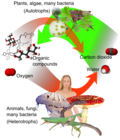Saprotrophic nutrition /sæprəˈtrɒfɪk, -proʊ-/ or lysotrophic nutrition is a process of chemoheterotrophic extracellular digestion involved in the processing...
7 KB (757 words) - 19:02, 17 March 2024
Saprotrophic bacteria are bacteria that are typically soil-dwelling and utilize saprotrophic nutrition as their primary energy source. They are often associated...
13 KB (1,510 words) - 12:51, 6 June 2024
photosynthesis to produce their own food from sunlight. Some fungi may be saprotrophic, meaning they will extracellularly secrete enzymes onto their food to...
3 KB (216 words) - 06:15, 20 May 2024
Detritivore (category Microbial growth and nutrition)
decomposers live by absorbing and metabolizing on a molecular scale (saprotrophic nutrition). The terms detritivore and decomposer are often used interchangeably...
10 KB (980 words) - 02:51, 17 March 2024
The first method of acquiring nutrients is through saprotrophic nutrition. In saprotrophic nutrition, nutrients are obtained from dead organic matter through...
32 KB (3,716 words) - 16:28, 15 December 2023
externally and then absorb the products. This process is called saprotrophic nutrition. Fungi are examples of saprobiontic organisms, which are a type...
2 KB (186 words) - 18:46, 9 February 2024
internal nutrition, as well as the main two types of fungi that are most often referred to, as well as describes, visually, the process of saprotrophic nutrition...
27 KB (2,935 words) - 20:11, 6 April 2024
Hymenochaetaceae. Like other members of the genus of Phellinus, it lives by saprotrophic nutrition, in which the lignin and cellulose of a host tree is degraded and...
5 KB (551 words) - 09:24, 15 April 2024
and minerals are absorbed; here the digestion is intracellular. Saprotrophic nutrition Advanced Biology Principles, p296, fig 14.16—Diagram detailing the...
14 KB (1,800 words) - 15:34, 8 April 2024
which include "saprophytes" known to consume decaying matter (saprotrophic nutrition). Pathogenic Leptospira do not multiply in the environment. Leptospira...
76 KB (8,089 words) - 07:44, 1 June 2024






